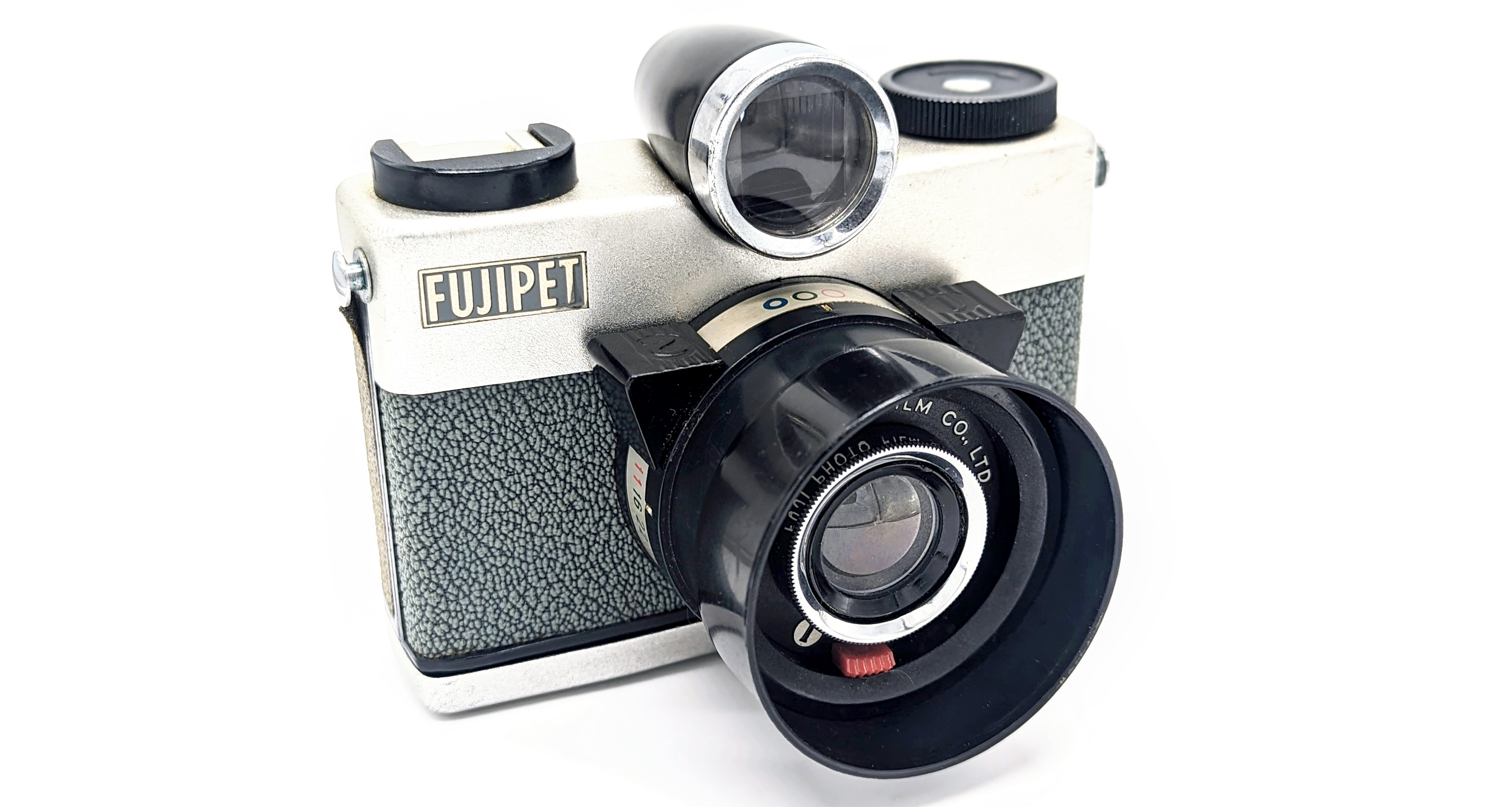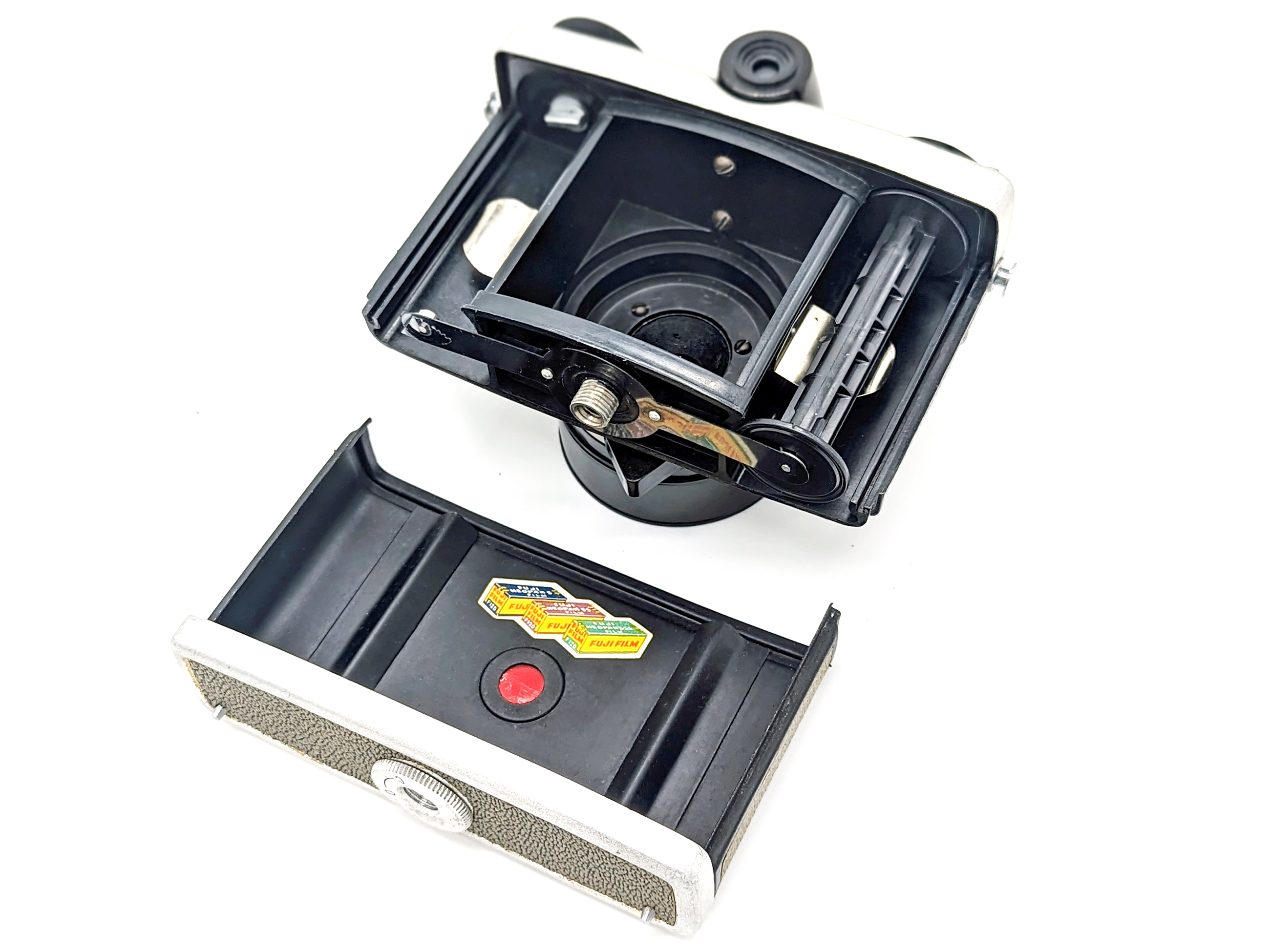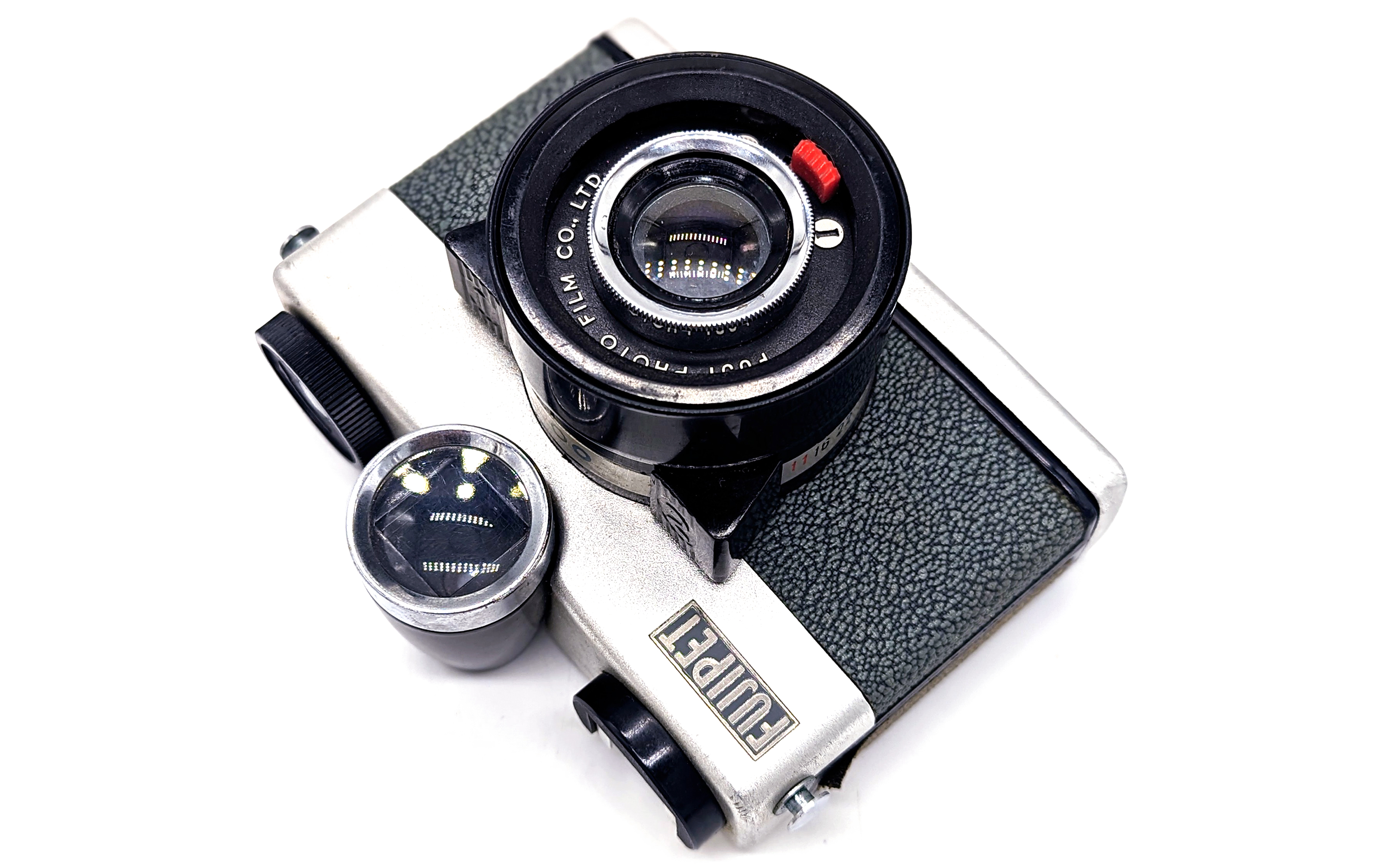
The Fuji Fujipet is a model in a fascinating series of 6×6 cameras that were sold primarily in the Japanese home market from 1957 to 1963. The original model (pictured here) has a fixed 70mm f/11 meniscus lens (with a claimed 1.00m to infinity depth of field), with user-selected aperture settings of f/11, f/16, or f/22, a leaf shutter with a fixed 1/60 (or is it 1/50?) shutter speed with a “B” setting, and a flash sync port on the lens housing. Combine those features with what appears to be an auxiliary viewfinder fused to the body and a primitive, non-locking film transport system, and you have a sort of primitive medium format point-and-shoot.
In 1961, the Fujipet underwent a major revision (the “EE”), by: (1) adding an integrated viewfinder; and (2) using an autoexposure system using a selenium meter with continuous-variable aperture between f/11 and f/22; and (3) employing just one lever that both tripped and cocked the shutter. In doing so, the EE eliminated any manual aperture control, its selenium meter was calibrated only to work with 100 speed film, and “B” mode for longer exposures was omitted. A swinging arm in the viewfinder would indicate whether the photo would be exposed correctly in the f/11-f22 range. The final Fujipet revision (the “EE-2”) added a meter sensitivity dial, presumably to accommodate different film speeds.
Subsequent cameras similar to the Fujipet have included the 1960s “Diana” and the 1980s “Holga,” both of which originated in Hong Kong. It could be argued that the Fujipet (at least the non-EE models) is as good or better than either the Diana or the Holga, as it can produce pretty acceptable images with no vignetting, albeit the field flatness and visual distortion can be a bit unpredictable given the interplay between the lens and the slightly curved film position. Although functional Fujipets are a little hard to find outside of Japan, are they worth wasting your precious 120 film on? Let’s take a look.

Operation
Exposure/Shutter: Although the Fujipet’s leaf shutter has just the single speed of 1/60 (or 1/50, it is not clear), the fact that the user can select an aperture of f/11, f/16, or f/22 via a ring around the lens, you should be able to take a well-exposed daylight photo with any film in 100 to 400 ASA range. The three aperture settings are represented as various different circles at the 12 o’clock position when looking down at the lens. There is also a “B” setting which is activated on a switch beneath the lens. Cocking and firing the shutter is accomplished via two levers on the side of the lens, marked “1” and “2.” What is nice is that if you do not click “1” then “2” after a shot, the shutter cannot trip accidentally.
Fixed-Focus Lens: The @ 70mm f/11 in the Fujipet is a simple meniscus lens, the equivalent of maybe a 45mm field of view in the 35mm format. It is not bad and has pretty good sharpness and almost no corner light fall-off. However, the interaction of the lens and the slightly curved film plane result in some pretty weird distortion given the distance to the subject and/or tilting the camera up or down from a level position. In other words, to minimize weird effects and distortion, try to keep the lens as level with the subject as possible. While Fuji claims that the depth of field spans 1.00m to infinity, it would have been nice if the lens did have a few pre-set focus positions.
Film Transport: Loading the Fujipet is pretty easy. You unscrew the camera back via the tripod mount, and then pull it out. The film transport system is quite primitive. Using the red window on the back, you have to advance the film until the “1” on the backing paper is visible. Because the transport system does not lock the advance until the shutter is tripped, you take the photo and then have to advance the film via the knob until the “2” appears in the red window, and so on. It is quite easy to accidentally double expose if you do not remember to advance the film immediately after each shot.
Viewfinder: The viewfinder appears to be an external one just attached to the top of the camera. It is clean and clear and has no framelines. Point and shoot, my friends.
Strap Lugs: The Fujipet uses just simple dimple-type strag lugs. You will either need to get a set of those metal brackets that can fit around the round mounts to use a regular strap or a strap that has “string” ends that can be wrapped and knotted around the lugs.
Slide-Out Lens Hood: The Fujipet contains a built-in sliding lens hood, but unfortunately it does not lock into place.
Film Flatness: The Fujipet has no pressure plate to flatten the film. Instead, the film chamber and the camera back contain curved molding that when put together seem to have the effect of somewhat tensioning, flattening, and then slightly curving the film plane.
Flash: The camera has a cold shoe on the right side of the top cover. On the underside of the lens housing is a small PC port for flash, which requires the non-locking lens hood to be extended to access. While apparently engineered for flash bulbs, the sync seems to work ok with modern electronic flashes. However, because the Fujipet requires shooting at f/11-22, you may need to use a pretty powerful flash to reach beyond a few feet of coverage.
Filters: The Fujipet does not have a standard filter thread. Instead, Fuji made custom filters for the system that are very difficult to find today.

Versus the Later Models
I think the original non-EE Fujipet is the one to get. The selectable apertures and the “B” setting provide at least some user control over the exposure. The EE version depends on the operability of its selenium meter, has no user override over the exposure settings, and is limited to ASA 100 film. Also remember that simple selenium meters can be easily fooled by any strong backlight, and there is no way to override the EE’s autoexposure system. The EE-2 with its meter sensitivity lever is probably a better option than the EE, but I think it’s just easier and more accurate to take a meter reading and set the f/11-22 aperture yourself.
Conclusion
Maybe this is all lost to history, but it is not clear to me to whom the Fujipet was effectively marketed. While a primitive “point-and-shoot” camera may have appealed to all sorts of people unfamiliar with or unwilling to engage in the intricacies of film photography at the time, 120 film was certainly not cheap either to purchase or develop. If you are coming from the world of “real” photography, cameras like the Fujipet can be quite aggravating because you think of all of the ways it could have been better. However, for what it is, the Fujipet remains a very cool device. With some limited exposure control, the nice big 120 format, and the ability to use it with a flash as an indoor snapshot camera, there are certainly enjoyable ways to use it. If you want to see some sample photos, check out the #fujipet tag on the IG link above.